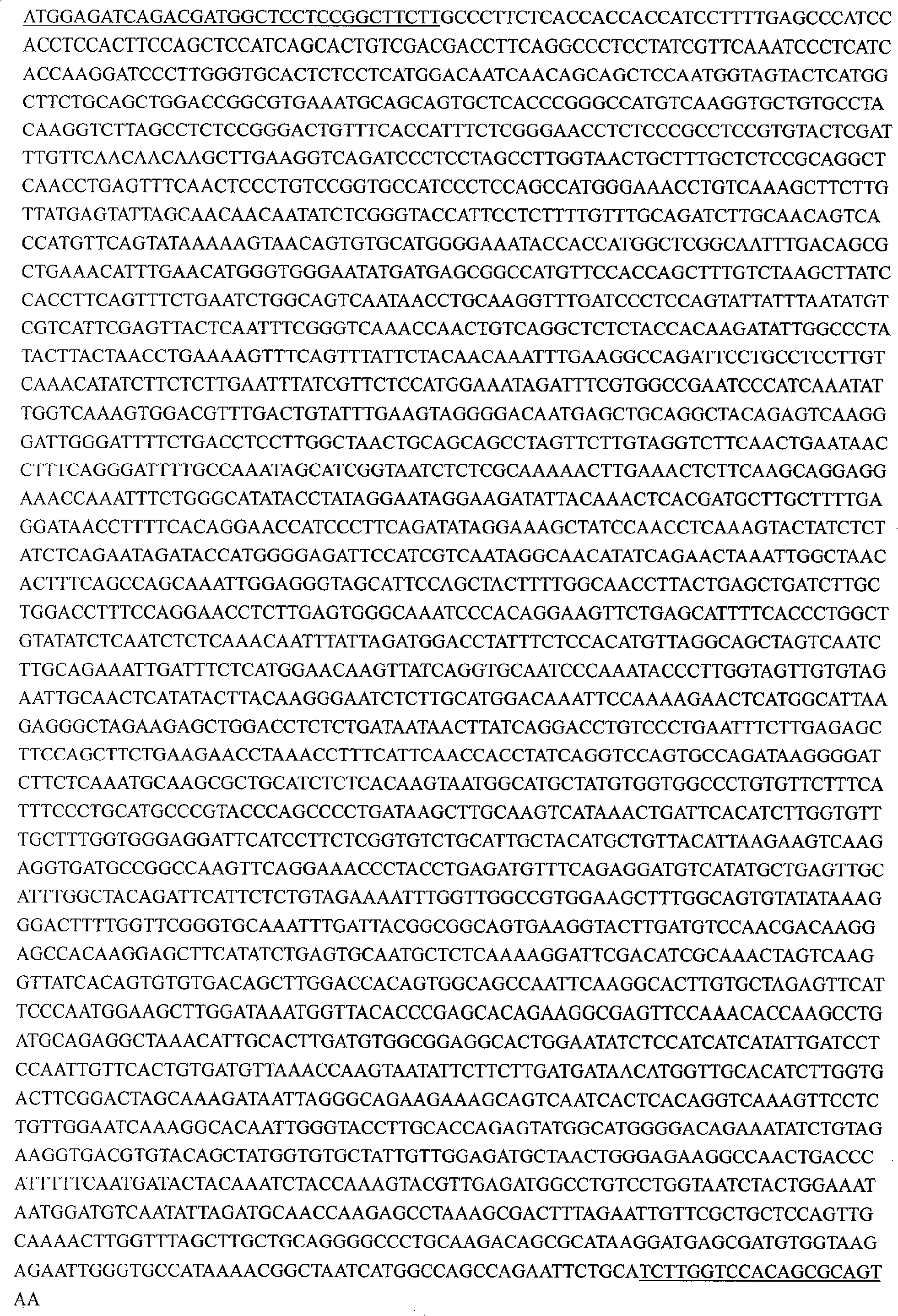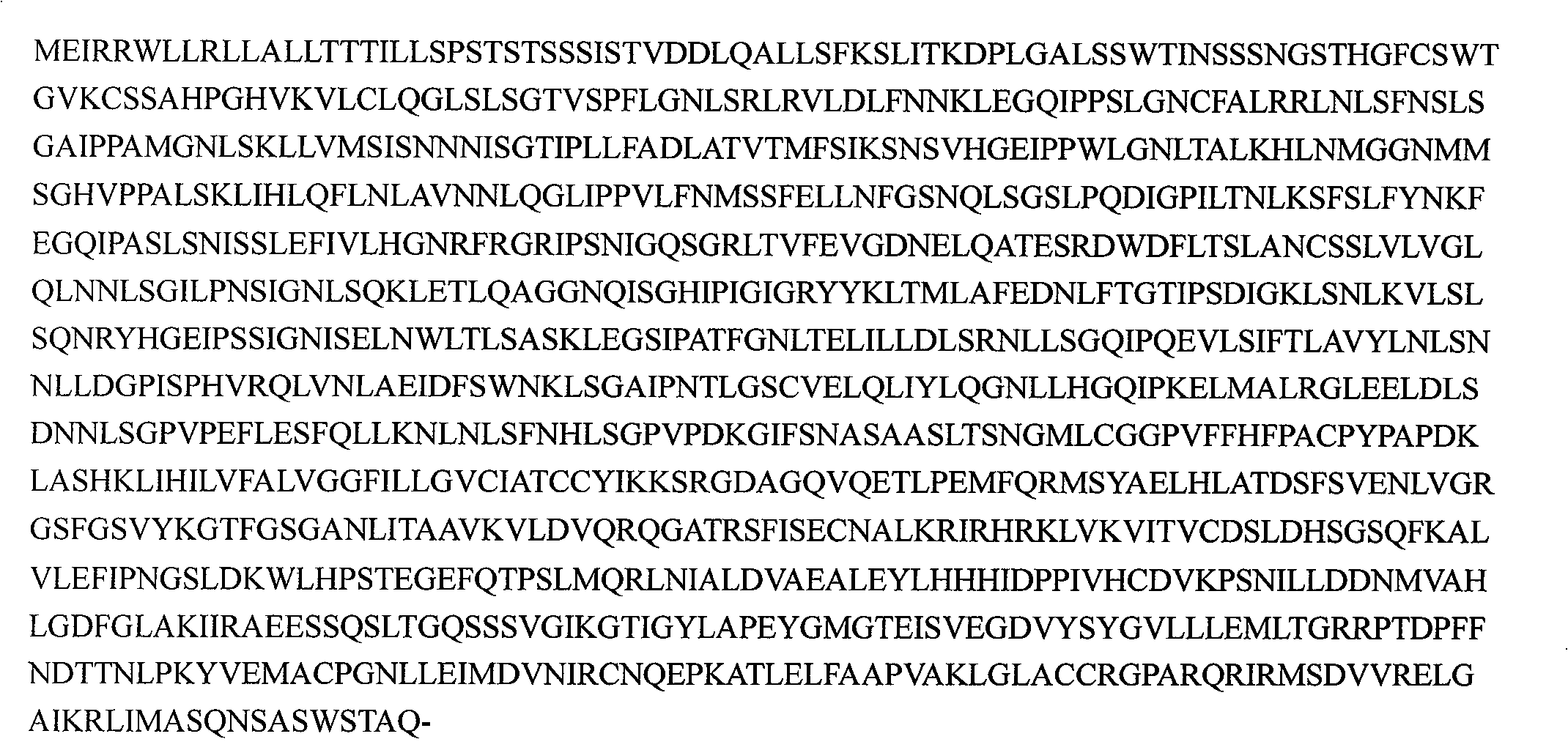Emmer wheat LRR-receptor protein kinase gene, and cloning method and use thereof
A receptor protein, emmer technology, applied in application, genetic engineering, plant genetic improvement, etc., can solve problems such as limiting gene function
- Summary
- Abstract
- Description
- Claims
- Application Information
AI Technical Summary
Problems solved by technology
Method used
Image
Examples
Embodiment 1
[0037] The cloning process of embodiment 1.TtLRR-STK gene:
[0038] The TtLRR-STK gene was isolated from emmer wheat, which is highly resistant to wheat diseases. Extract total RNA (ribonucleic acid) from the leaves of emmer wheat, further isolate mRNA (messenger ribonucleic acid), transcribe mRNA into cDNA (complementary deoxyribonucleotides) by reverse transcription, and use the cDNA as a template for Gene cloning.
[0039] A pair of degenerate primers (sequence: 5'-GTATTG(A / G)TTTTCTTTGCCTGG(A / C)C-3'; 5'- CAAGC(A / C)GT(A / C)CGTCCAATC(T / A)AT-3'), a cDNA fragment with a coding sequence length of 3081bp was obtained from emmer wheat cDNA by reverse transcription PCR (RT-PCR) technology , cloned on the pUC18-T vector, sequence analysis after sequencing proved that this cDNA clone encodes leucine-rich region-serine / threonine receptor protein kinase (LRR-Serine / Threonine receptor protein kinase). The similarity query and comparison in GenBank proved to be a new emmer gene, tentat...
Embodiment 2
[0049] Example 2. Application of the TtLRR-STK gene of the present invention in transgenic disease resistance breeding.
[0050] The TtLRR-STK gene was digested from the pUC18-T vector, or amplified with high-fidelity Taq-DNA polymerase and gene-specific primers. Use T4-DNA ligase to connect TtLRR-STK to the downstream of maize ubiquitin high-efficiency promoter Ubi (Ubiquitin-1), and then insert it into the pCAMBIA-Bar plant expression vector to construct the pCAMBIA-Ubi-TtLRR-STK expression vector plasmid. The expression vector is transformed into Escherichia coli DH10B bacterial strain for propagation, and the plasmid of the vector is extracted to carry out transgenic disease-resistant breeding. Transform the pCAMBIA-Ubi-TtLRR-STK expression vector plasmid into the callus of immature embryos of wheat varieties with high yield and high quality but poor disease resistance by gene gun (such as Bio-Rad’s high-pressure helium gene gun, PDS-1000 / He) middle. Using the selection...
Embodiment 3
[0051] Example 3. The TtLRR-STK gene of the present invention is designing and synthesizing new disease resistance-related genes.
[0052] Modern DNA synthesis technology has been able to synthesize full-length genes. Therefore, according to the characteristics of the plant LRR-protein kinase disease-resistant genes that have been cloned and studied, the sequence encoding the specific LRR domain required for synthesis is designed and synthesized, and it can be synthesized by linking with the sequence encoding about the 600th amino acid of TtLRR-STK Novel LRR-serine / threonine receptor protein kinase gene. Then, the correct coding frame (ORF) of the synthetic gene was verified by sequencing. The verified gene can be further constructed into a plant expression vector, and the disease resistance of the synthetic gene can be tested by transgenic technology. Synthetic genes with good disease resistance can be used in the breeding of new transgenic disease-resistant wheat varieties...
PUM
 Login to View More
Login to View More Abstract
Description
Claims
Application Information
 Login to View More
Login to View More - R&D
- Intellectual Property
- Life Sciences
- Materials
- Tech Scout
- Unparalleled Data Quality
- Higher Quality Content
- 60% Fewer Hallucinations
Browse by: Latest US Patents, China's latest patents, Technical Efficacy Thesaurus, Application Domain, Technology Topic, Popular Technical Reports.
© 2025 PatSnap. All rights reserved.Legal|Privacy policy|Modern Slavery Act Transparency Statement|Sitemap|About US| Contact US: help@patsnap.com



